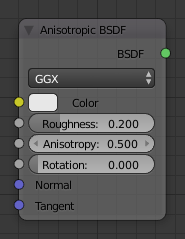Anisotropic Node¶

Anisotropic Node.
The Anisotropic BSDF node is used to add a glossy reflection, with separate control over U and V direction roughness. The tangents used for shading are derived from the active UV map. If no UV map is available, they are automatically generated using a sphere mapping based on the mesh bounding box.
Inputs¶
- Color
- Color of the surface, or physically speaking, the probability that light is reflected for each wavelength.
- Roughness
- Sharpness of the reflection; perfectly sharp at 0.0 and smoother with higher values.
- Anisotropy
- Amount of anisotropy in the reflection; 0.0 gives a round highlight. Higher values give elongated highlights orthogonal to the tangent direction; negative values give highlights shaped along the tangent direction.
- Rotation
- Rotation of the anisotropic tangent direction. Value 0.0 equals 0° rotation, 0.25 equals 90° and 1.0 equals 360° = 0° . This can be used to texture the tangent direction.
- Normal
- Normal used for shading; if nothing is connected the default shading normal is used.
- Tangent
- Tangent used for shading; if nothing is connected the default shading tangent is used.
Properties¶
- Distribution
- Microfacet distribution to use. Sharp results in perfectly sharp reflections like a mirror, while Beckmann, GGX and Ashikhmin-Shirley can use the Roughness input for blurry reflections.
Outputs¶
- BSDF output
- Standard shader output.
Examples¶

Anisotropic rotation on 0. |

Anisotropic rotation on 0.25 (90°) |